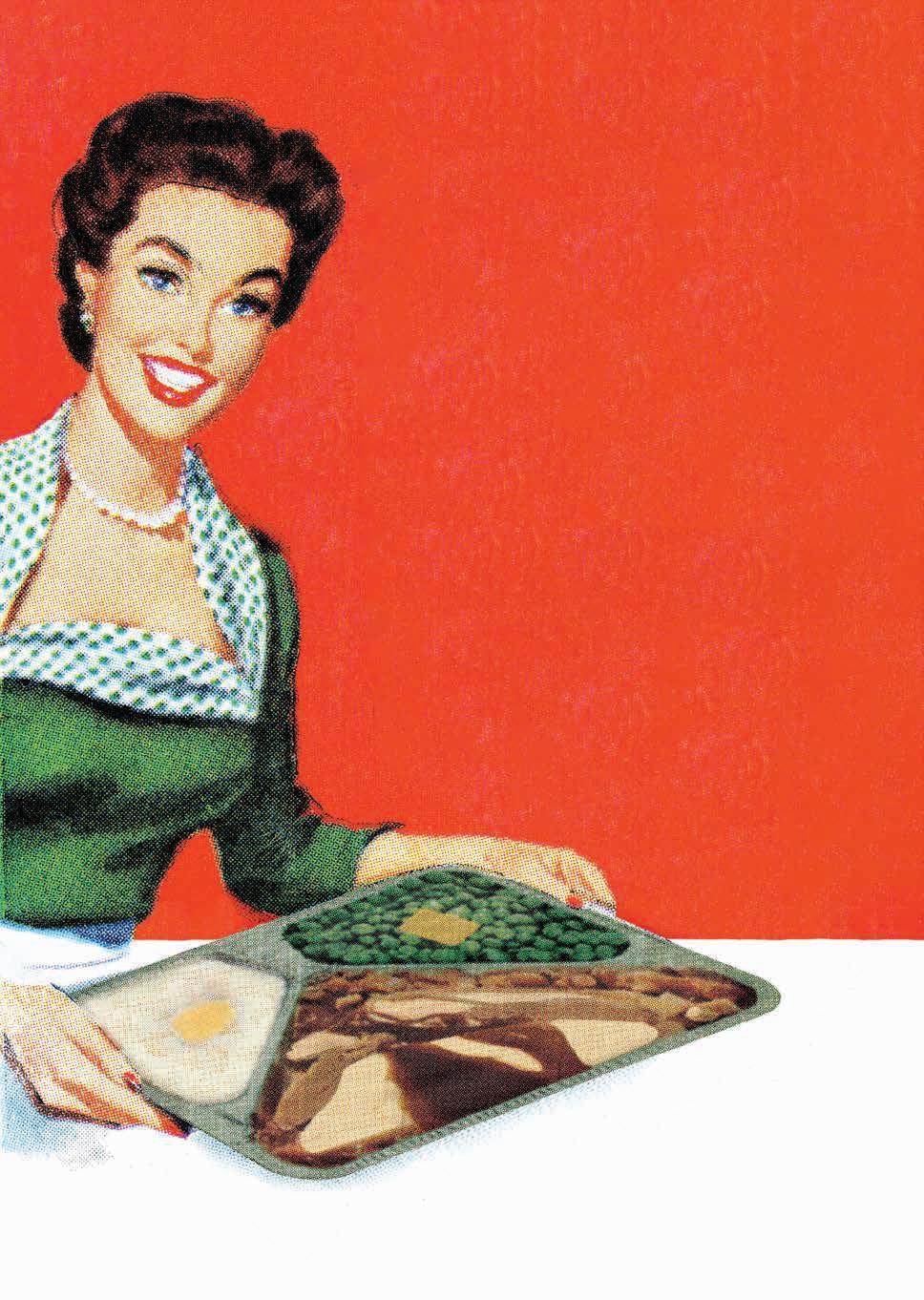
3 minute read
HEAT -ANDEAT
the tv dinner’s nebraska roots run deep
hile it is accepted lore that the much beloved Reuben was conceptualized in 1920s Omaha, there is a significant amount of speculation and contention between metro establishments all claiming to have been the first to serve the salty sandwich. Similarly, the facts behind the creation of the TV dinner has been the subject matter of debate since the ’50s.
Carl Swanson immigrated at the age of 17 with his family from Karlskrona, Sweden, to Nebraska in 1896. From there, he settled among Omaha’s Swedish population, which occupied “Little Stockholm” from Cass to Cumming Streets, and the Gifford Park area. Swanson paid his dues learning English and working the land on a farm in Blair, Nebraska, before partnering with the Jerpe Commission Company in 1899. The company specialized in transporting eggs, milk, and dairy products from farmers to Omaha hotels and groc ery stores.
Swanson’s insights and work ethic bolstered company growth, and soon Jerpe expanded to chicken, turkey, and other meats. When Swanson’s sons, Gilbert and Clarke, were ready to enter the business, Carl purchased Jerpe and renamed the venture C.A. Swanson and Sons.
The story of how Swanson’s came to exist isn’t where the dispute lies determining how, exactly, frozen dinners came into the public lexicon is where the rub is.
Innovation On Ice
Innovator, inventor, and naturalist Clarence Birdseye discovered the benefits of flash-freezing after purchasing land in Muddy Bay (Newfoundland and Labrador, Canada). The Native population educated him in Inuit ice fishing techniques, where he learned that fish he caught in the -40° temps were freezing instantly, and that when thawed, maintained their freshness better than any seafood he had experienced living i n New York.
This inspired the trial-and-error invention of Birdseye’s signature food preservation and quick-freezing methods, including the double belt freezer. In 1929, Birdseye sold his business and his patents to what would eventually become General Foods. He continued to work with the company to develop preservative technology, and General Foods ultimately founded the Birds Eye Frozen Food Company in his honor.
While most households owned a refrigerator in the year 1930, not many of them came with ice boxes. Still, the company began to test consumer confidence in flash-frozen fruits, vegetables, and meats, and this relationship marked the official beginning of the direct-to-consumer retail frozen food phenomenon.
Test Flight
Birdseye’s double belt freezer was the key ingredient in Maxon Food System’s enthusiastic proposal to introduce complete frozen dinners to airlines in 1945. William L. Maxon, well known for his invention of the forced-convection oven, made the now popular air fryer possible. Despite his best efforts, however, he fell just short of being named the progenitor of the TV dinner.
His original intention was to improve the dining experience of servicemen traveling with the US Navy. His Sky Plate (or StratoPlate, according to some accounts) “blue plate specials” were partially cooked before being frozen, and he had expanded to offering ham, meatloaf, beef stew, franks and beans, steak, and veal cutlets. While the idea was well received, attempts to expand to retailers fell apart upon the death of Maxon’s founder, the irreplaceable William L. Maxon himself.
Holiday On Ice
The collision of Birdseye’s flash-freezing technology and Maxon’s heat-and-eat dining idea came about in 1953. A salesman for the Swanson company, Gerry Thomas, heard about a company frantically trying to preserve 260 tons of raw Thanksgiving turkey being shuttled back and forth between the Nebraska headquarters and the East Coast without a plan for unused product. At the time, refrigerated train cars only cooled while the train w as running.
Thomas had the idea to add other holiday staples like stuffing, vegetables, gravy, and sweet potatoes. Meanwhile, Swanson’s bacteriologist, Betty Cronin, cracked the code on how to heat the meat and vegetables at the same time, killing bacteria without resulting in a plate of soggy mush.
While many at the Swanson company attribute the invention of the TV dinner to Gilbert and Clarke Swanson, and the family’s heirs have long contested the account of Thomas’s discovery, most stories continue to cite Gerry Thomas’s recollection as the product’s t rue genesis.
The invention gained steam as women entered the work force in droves in the early ’50s. While wives and mothers had less time in the kitchen to prepare daily meals for their families, Swanson’s TV dinner made it possible for anyone even a 1950s husband to pop a tray into the oven and enjoy a hot meal just 25 minutes later.
Fast Food Gets Faster
Officially introduced in 1953, Swanson sold 5,000 trays upon launching. Just one full year into production, the company had reached ten million TV dinner sales. Two years later, Swanson’s was acquired by the Campbell Soup Company, and a year later, hit annual sales of over $13 million.
Soon, other companies were following Swanson’s lead and introducing their own frozen meals. Stouffer’s and Lean Cuisine took the lead on innovation, each using a new angle to attract busy families, from touting “international flavors” to advertising weight loss through portion control.
The introduction of microwavable trays made the convenience food a no-brainer as single parent households and dual-income families struggled to squeeze meals in between ever-increasing demands on family time. Today, freezer sections are filled with comfort classics, keto-compliant options, exotic dishes, and allergen-free fine foods, and while it is now rebranded as Hungry Man, the original Swanson’s turkey TV dinner survives frozen in time, unthawed at a moment ’s notice.
Visit
MAX ROSELAND RACES AHEAD WITH RESILIENCE, FAMILY SUPPORT











